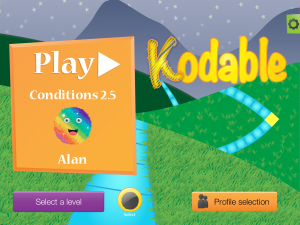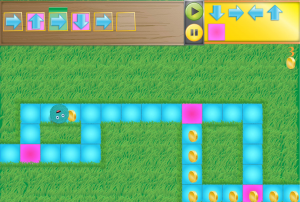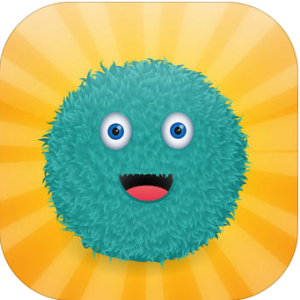“The furry aliens, known as Fuzzes, were exploring space when their ship unexpectedly crashed on the maze-covered planet Smeeborg. The naturally curious fuzzes need kids to program them to explore all the colorful Technomazes on the planet’s surface”.
This introduction by the iPad app’s developer perfectly captures what kids will think they are doing while using Kodable (free with in-app purchases). What they will not realize is that at the same time they will also learn the fundamentals of every modern programming language, including:
– Sequence/Order of operations
– Algorithmic operations
– Conditional logic statements
– Problem solving skills
– Higher level thinking skills
– Collaboration skills
– Communication skills
– Critical thinking skills
 The home screen of Kodable allows a user to create and select profiles, and as the user progresses, he or she can select which level to play.
The home screen of Kodable allows a user to create and select profiles, and as the user progresses, he or she can select which level to play.
 The game begins with the Fuzz on the left side of the screen, and the play has to place the arrows from the yellow box into the squares in the brown box in the order that will help the Fuzz reach the right side of the maze and collect the coins in the process. Once the arrows are placed, the player presses the green play button to check how their algorithm works.
The game begins with the Fuzz on the left side of the screen, and the play has to place the arrows from the yellow box into the squares in the brown box in the order that will help the Fuzz reach the right side of the maze and collect the coins in the process. Once the arrows are placed, the player presses the green play button to check how their algorithm works.
Possible GELDS Connections
PDM3.4b Demonstrates spatial awareness through play activities.
PDM6.4a Performs fine-motor tasks that require small-muscle strength and control.
APL1.4a Takes initiative to learn new concepts and try new experiences. Initiates and completes new tasks by himself/herself.
APL1.4b Selects and carries out activities without adult prompting.
APL1.4c Sets goals and develops and follows through on plans.
APL3.4a Engages in independent activities and continues tasks over a period of time.
APL3.4b Practices to improve skills that have been accomplished.
APL3.4d Persists in trying to complete a task after previous attempts have failed.
APL5.4c Demonstrates inventiveness, imagination and creativity to solve a problem.
APL5.4d Considers a variety of possible solutions and exhibits flexibility if an alternate approach is suggested by a peer or adult.
MA5.4a Uses appropriate directional language to indicate where things are in their environment: positions, distances, order.
SS4.4d Explores the uses of technology and understands its role in the environment.
CP1.4a Recognizes cause- and- effect relationships.
CP2.4b Uses observation and imitation to transfer knowledge to new experiences.
CP2.4c Uses information gained about familiar objects and people, and can apply to a new situation.
CP2.4d Makes, checks and verifies predictions.
CP3.4b Uses both familiar and new strategies to solve a problem.
CP3.4c With adult guidance and questioning determines and evaluates solutions prior to attempting to solve a problem.


